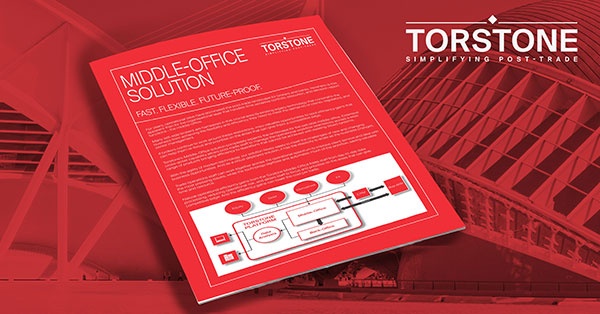The rise of digital assets and shrinking of post-trade settlement times are both driving financial institutions to automate their middle-office operations for much needed flexibility and efficiency. In a DerivSource commentary, Brian Collings, CEO of Torstone Technology, explains how firms are future-proofing their middle office to reduce the total cost of ownership, prolong the life of back-office systems and support rapidly evolving market needs.
Historically, the middle office has been organised in silos by region and asset class and more closely aligned to the front office than the back office. However, regulatory changes, increasing operational cost and market pressures are driving the trend for financial institutions to combine those middle-office operational processes onto a single, global, cross-asset platform, which reduces operation running costs and improves flexibility and scale.
Regulation and real-time needs
The US and Canada are shortening the securities settlement cycle from T+2 to T+1 by mid-2024. This means trade settlement needs to take place the day after execution, which removes the window for any legacy batch processing. Trade settlement therefore needs to start in real time. Likewise, the European Union’s Central Securities Depositories Regulation (CSDR) is driving a need for improvements and automation in the middle office to reduce settlement failures and associated fines for industry participants. The front office is also pushing for greater automation and real-time analysis because settlement failures and fines will impact the profitability of their positions.
Beyond the regulatory drivers, there is a push to reduce the Total Cost of Ownership (TCO), particularly given recent market volatility. A cross-asset middle office, especially one that combines equities and fixed income, would provide opportunities to consolidate those separate teams and reduce operating costs.
Lastly, the newest generation of investors are increasingly interested in trading digital assets, such as cryptocurrencies, and investment firms need new post-trade infrastructure to manage this. These assets require same-day settlement—it is not even T+1—and seven days per week. That is a completely real-time requirement all the way through from middle to back office. We are seeing the ability to include digital assets in portfolios is a key and growing driver for improvements in post-trade processing among financial institutions.
Collectively, these market trends require closer integration between the middle and back office. More automation throughout the trade lifecycle will make post-trade processing more efficient and will knit the middle and back office together in a more cohesive way from a cross-asset perspective. Contrary to the historical alignment with the front office mostly, in future we will see a more unified middle office taking data from multiple front-office systems and combining them to feed through to the back office.
Decoupling the middle office away from the front office gives the front office more freedom when choosing execution systems and this will be even more important with the rise of digital assets as traders look to deploy best-of-breed trading execution systems.
Firms need to speed up processing, but there is no point in speeding up a bad process.
Data timeliness and legacy systems pose challenges
Firms need to speed up processing, but there is no point in speeding up a bad process. Some of the blockages in straight-through processing (STP) are around data quality and data timeliness. In the settlement process, for example, it is important to have an accurate Standard Settlement Instruction (SSI). Getting an automated feed rather than relying on a manual process is vital. The same automation could extend to the allocation process, even pre trade. For example, if a firm allocates specific orders to a set of funds in advance, that could be defined upfront, which would also bring the processing forward rather than just speeding it up.
Application programming interfaces (APIs) are a great advancement for pulling data from one system to another. As firms move towards standardising the way they use APIs, this makes data transfer easier and better defined. Torstone’s platform has a low-code layer that allows for better automation while giving us the opportunity to tap into different services from other providers quickly. This setup supports improved timeliness of data. Rather than relying on a full update, users can simply access the data they need, which makes the whole process much smoother.
Legacy systems remain a challenge too. Firms cannot change all their legacy systems in one go—it is a long-term issue. By focusing on the middle office, financial institutions can protect their legacy settlement systems from these changes. Building a flexible, future-proof middle-office system does not remove the need to replace legacy back-office systems, but it can help get over some of the immediate hurdles such as regulatory change. And it can ease the pressure on the back office and become a stepping-stone towards future back-office upgrades.
In other words, improving the middle-office systems can help a firm get a global view of its settlement data—or a cross-asset view of its equities and fixed income positions—which would lead to a reduced TCO, without the need to immediately change anything in the back office.
Building a flexible, future-proof middle-office system does not remove the need to replace legacy systems, but it can help get over some of the immediate hurdles such as regulatory change.
The value of cloud and pre-trade risk strategies
Using cloud-based solutions in the post-trade process is essential. Use of cloud solutions reduces time to deployment, they are more agile and can be updated easily, and are more likely to be cross asset supportive and capable of dealing with digital assets already. Cloud technology helps firms future-proof themselves against changing market trends.
Mixing the cloud base with APIs enables firms to use the best of breed and ensures easier connectivity with existing systems. When bringing in a new cloud-based system, that system can access the necessary data through APIs. In turn, this improves automation because it delivers the right information to the right place at the right time.
For financial institutions beginning the process of future-proofing their middle office, Torstone works with them on the “Foundation Phase”, to help them identify their best opportunities. Saving TCO on one product can lead to TCO savings on other areas. The more global and more cross asset, the greater the TCO savings will be. But firms have different risk appetites in terms of how much they want to change at one time. For example, do they want to start with a particular region or asset class? Some companies want to see evidence the strategy is working before they commit to the next stage.
A note of caution: A main aim of reducing the settlement cycle is to reduce capital and settlement risks. There are substantial savings to be had with that capital reduction. But at the same time firms need to be sure they are not introducing new operational risks, which would reverse those gains. Bringing down the settlement cycle to almost zero in the case of digital assets, firms need to make sure there is still adequate and timely risk analysis taking place. There is therefore a need for greater intra-day, real-time, consolidated risk management, especially in the digital assets space.
Next steps for firms
Banks need to think about the level of flexibility they will need from their technology base going forward. Increasing flexibility and future-proofing their technology stack does not mean they need to replace everything at once, because middle office improvements can help ease the pressure in the back office in the short term and increase the life span of the back-office systems.
Firms can focus on the middle office now to enable them to address inefficiencies in the back office later.




